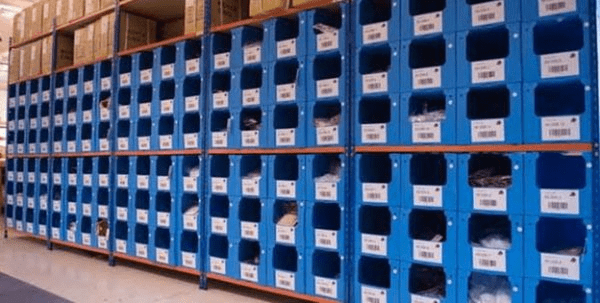Warehouse efficiency should always be a priority for eCommerce and order fulfillment services. With the right order picking strategies in place, it’s possible to ship orders faster, reduce operating costs, and prevent mistakes.
If you’re looking to improve the efficiency of your warehouse, here are some different order picking strategies that you can begin implementing today. These warehouse picking optimization strategies can help you maximize profit and employee productivity:
- Discrete order picking
- Wave picking
- Batch or multi-order picking
- Cluster picking
- Zone picking
- Picking stations
Understanding your options when it comes to warehouse picking strategies and the best ways to leverage them for your business is crucial for warehouse picking optimization.
What Determines Warehouse Efficiency?
Even if you have existing warehouse picking strategies in place, they may not be the most effective systems in terms of cost and efficiency. Efficiency goes beyond warehouse picking strategies, as employee numbers, warehouse layout, packaging, and product type can affect how you choose an order picking practice.
There are over 1.7 million employees in the warehouse and storage industry. Staffing is crucial for efficiency since an understaffed warehouse won’t be able to keep up with the order volume. Tech tools can support warehouse operations, from software that generates optimized picking routes to LED bulbs that light up to help pickers find the SKUs they need to pick.
There are currently over 16 billion square feet of warehouse space in the U.S. Optimizing your layout is one of the best order picking strategies to implement because it helps pickers navigate the warehouse space more effectively. If you’re looking to find a method for warehouse picking, the best practices can prevent errors and help you achieve an order accuracy better than the median rate of 99.4%.
Order picking strategies should fulfill several criteria to reach warehouse picking optimization. It might require some mixing and matching of strategies and rearranging layouts and processes:
- Seamless transition from packing and shipping
- Establishing a clear order labeling system.
- A well-designed process for receiving bulk shipments, refilling shelves, and tracking different SKUs
Each of these order picking strategies can give you an edge in your industry and help your employees be as productive as possible.
How to Choose the Right Order Picking Strategies
The right warehouse picking strategies for your business will depend on the size of the warehouse and the type of items you usually ship. It’s also important to consider the order fulfillment time you’re aiming for, the average order size, and whether some SKUs are more popular than others.
Analytics is a valuable tool for tracking performance and improving your order picking strategies to optimize warehouse efficiency. You can use data to identify patterns in your current fulfillment process, such as:
- Popular SKUs
- Accuracy rates
- Average fulfillment times
- And more
This information can help you identify areas that need improvement and give you a better idea of which warehouse picking strategies would make the most sense for your organization. You can then adopt warehouse picking best practices to share with your team, new employees, and temporary staff so that everyone is on the same page.

Top Warehouse Order Picking Strategies to Consider
A majority of warehouses and storage facilities use one of these popular order picking strategies to improve efficiency and build a list of warehouse picking best practices. Depending on your space, products, and layout, you might need to mix and match these order picking strategies to optimize your team’s efficiency.
#1. Discrete Order Picking
Discrete order picking is one of the more popular warehouse picking strategies because it’s easy to implement. It works best for small warehouses where a single picker can easily cover the entire surface within a picking window.
With discrete picking, employees work on a single order at once. They will pick each individual SKU and add it to their cart. It’s a great way to improve accuracy since pickers are focusing on a single order at a time.
The downside of discrete order picking is that it’s time-consuming, especially if you have a large inventory. Walking through the entire warehouse to fulfill a single order can be exhausting for employees.
Discrete picking is a viable strategy for businesses that handle a reasonable volume of orders and that don’t need to ship items on a tight deadline. You can also consider this strategy if you’re optimizing order picking in a small warehouse or can provide vehicles to help employees travel through the warehouse.
#2. Wave Picking
Wave picking is one of the more tactical order picking strategies. With wave picking, warehouse managers prioritize orders based on specific criteria. You can adapt this method to support your current goals. For instance, you can schedule waves for having employees work on all the orders that need to ship before noon, pick up large items that require a forklift to transport, or find all the SKUs in a specific zone.
Wave picking is one of the more flexible order picking strategies that works well in fast-paced environments. It’s also an excellent strategy for shipping frozen items or meeting priority shipping goals. Some warehouses use wave picking to prepare all the orders that will go out with a specific carrier within a window. You can schedule waves for restocking as well.
Note that you can combine this method with other warehouse picking strategies by scheduling waves at specific times and having pickers use another method when there is no wave on the schedule. For instance, you could adopt batch picking as your primary strategy and schedule a daily wave to catch up on orders that are getting close to the shipping deadline.
You can get more out of scheduling picking waves if you use customizable order picking products, such as customizable hopper bins.
#3. Batch or Multi-Order Picking
Batch picking is one of the order picking strategies that relies on employees handling multiple orders at once. They’ll typically use a cart loaded with different plastic trays to keep the orders organized.
The purpose of batch picking is to reduce travel time. It works well for warehouses with small product catalogs and it’s also a good strategy if some SKUs are more popular than others. If shoppers tend to place small orders or purchase a unique item, batch picking might be one of the better order picking strategies.
Batch picking allows you to improve your efficiency without complicating things for pickers since they’ll typically work on orders with the same SKUs. It reduces the risk of making mistakes.
#4. Cluster Picking
Cluster is similar to batch picking since workers fulfill several orders at the same time. However, there is an important difference between these cluster picking vs. batch picking methods. With batch picking, employees usually pick the same SKU multiple times, which makes batch picking ideal for fulfilling orders with your most popular products.
With cluster picking, pickers fulfill multiple orders with a wider range of SKUs. Their picking route will take them from one department to another as they add items to different color-coded plastic totes or bins, sorting them into specific categories, but working on multiple orders at the same time.
You’ll get better results if you use order fulfillment software that can group orders to optimize the path pickers take through the warehouse to save time. Determining which system helps pickers easily identify SKUs and reduce mistakes is the ultimate deciding factor in the cluster picking vs. batch picking debate.
#5. Zone Picking
Zone picking, or pick-and-pass picking, is one of the more difficult warehouse picking strategies to implement. However, this model helps you save time and contributes to improved picking accuracy.
With zone picking, each picker focuses on a zone or department. It allows them to become familiar with this area of the warehouse and learn where each SKU is. After a while, you’ll see better order picking times and improved accuracy as pickers become increasingly familiar with their zone.
If you adopt the zone picking method, workers will pick SKUs in their department before passing the cart to another picker who will add items from another zone. It requires a high level of coordination since you don’t want carts sitting around your warehouse waiting for the next picker to take over the order.
Zone picking is not ideal for all products or warehouses, but it’s one of the best options for certain businesses:
- Large warehouses with expansive inventories
- Perishable and non-perishable goods, including frozen food
- Controlled products, like pharmaceuticals
You can optimize your warehouse picking best practices by mixing zone picking and other strategies. Combining zone picking with wave and batch picking will increase productivity since you’ll be able to have the work spread out across the warehouse, but still keep everything organized.
#6. Picking Stations
Picking stations are among the least common warehouse picking strategies because they represent a significant upfront investment. With this model, robots bring pods loaded with products to stationary pickers. The workers then go through the pods to pick items and fill an order bin or work on multiple order trays depending on the picking model.
Picking stations are similar to zone picking, except that you store products in mobile pods instead of keeping them in a specific section of your warehouse. The picking stations method is worth mentioning because it’s the model that Amazon uses in its warehouses. It could become more popular in the future as pod technology becomes more affordable.

Wrapping It Up: The Power of Efficient Warehouse Picking Strategies
Adopting the right warehouse picking strategies can improve efficiency and reduce costs. It can also result in a less stressful environment for employees and help you meet customer expectations regarding shipping times and accuracy rates.
It’s essential to consider the unique characteristics of your warehouse and inventory when choosing the best order picking strategies to meet your needs. Then, assess your existing supplies to determine what equipment and tools you need to support those order picking strategies.
Finally, with all components in place, craft your list of warehouse picking best practices.
Here at MDI, we offer a wide selection of plastic corrugated products that include order fulfillment trays, bins, hoppers, and more. Contact MDI today to learn more about how our warehouse solutions and customizable plastic products can support your order picking strategies.